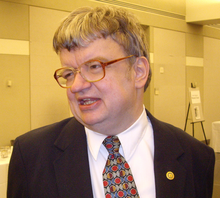Early life
Peek was born in Salt Lake City, Utah with macrocephaly, damage to the cerebellum, and agenesis of the corpus callosum, a condition in which the bundle of nerves that connects the two hemispheres of the brain is missing; in Peek's case, secondary connectors such as the anterior commissure were also missing. There is speculation that his neurons made unusual connections due to the absence of a corpus callosum, which resulted in an increased memory capacity. According to Peek's father, Fran Peek, Kim was able to memorize things from the age of 16–20 months. He read books, memorized them, and then placed them upside down on the shelf to show that he had finished reading them, a practice he maintained. He read a book in about an hour, and remembered almost everything he had read, memorizing vast amounts of information in subjects ranging from history and literature, geography, and numbers to sports, music, and dates. It is believed he could recall the content of at least 12,000 books from memory. Peek lived in Murray, Utah.Peek did not walk until the age of four and then in a sidelong manner. He could not button up his shirt and had difficulty with other ordinary motor skills, presumably due to his damaged cerebellum, which normally coordinates motor activities. In psychological testing, Peek scored below average (87) on general IQ tests.
Rain Man
In 1984, screenwriter Barry Morrow met Peek in Arlington, Texas; the result of the meeting was the 1988 movie Rain Man. The character of Raymond Babbitt, although inspired by Peek, was portrayed as having autism. Dustin Hoffman, who played Babbitt, met Peek and other savants to get an understanding of their nature and to play the role accurately and methodically. The movie caused a number of requests for appearances, which increased Peek's self-confidence. Barry Morrow gave Kim his Oscar statuette to carry with him and show at these appearances; it has since been referred to as the "Most Loved Oscar Statue" as it has been held by more people than any other. Kim also enjoyed approaching strangers and showing them his talent for calendar calculations by telling them on which day of the week they were born and what news items were on the front page of major newspapers. Peek also appeared on television. He travelled with his father, who took care of him and performed many motor tasks that Peek found difficult.Life after Rain Man
Unlike many savants, Peek had shown increasing social skills, perhaps due to the attention that had come with being perceived as the "real Rain Man". His father says that his sense of humor had been emerging since 2004 or so. Also, he had developed well beyond the stage of being a mere repository of vast amounts of information; his skills at associating information he remembered were at least one of the signs of creativity. He displayed difficulty with abstractions such as interpreting the meanings of proverbs or metaphorical terms of speechAlthough never a musical prodigy, Peek's musical abilities as an adult received more notice when he started to study the piano. He apparently remembered music he had heard decades before, and could play it on the piano to the extent permitted by his limited physical dexterity. He was able to give a running commentary as he played, for example, comparing a piece to other music he had heard. Listening to recordings, he could distinguish which instruments played which part and was adept at guessing the composers of new music by comparing the work to the many thousands of samples in his memory.
In 2004, Peek met another savant, Daniel Tammet, for the UK Channel Five documentary The Boy with the Incredible Brain. He hugged Tammet and said "Some day you'll be as great as I am".
Scientific investigation
In 2004, scientists at the Center for Bioinformatics Space Life Sciences at the NASA Ames Research Center examined Peek with a series of tests including computerized tomography and magnetic resonance imaging. The intent was to create a three-dimensional view of his brain structure and to compare the images to MRI scans done in 1988. These were the first tentative approaches in using non-invasive technology to further investigate Kim's savant abilities.A 2008 study concluded that Peek probably had FG syndrome, a rare genetic syndrome linked to the X chromosome which causes physical anomalies such as hypotonia (low muscle tone) and macrocephaly (abnormally large head).


No comments:
Post a Comment